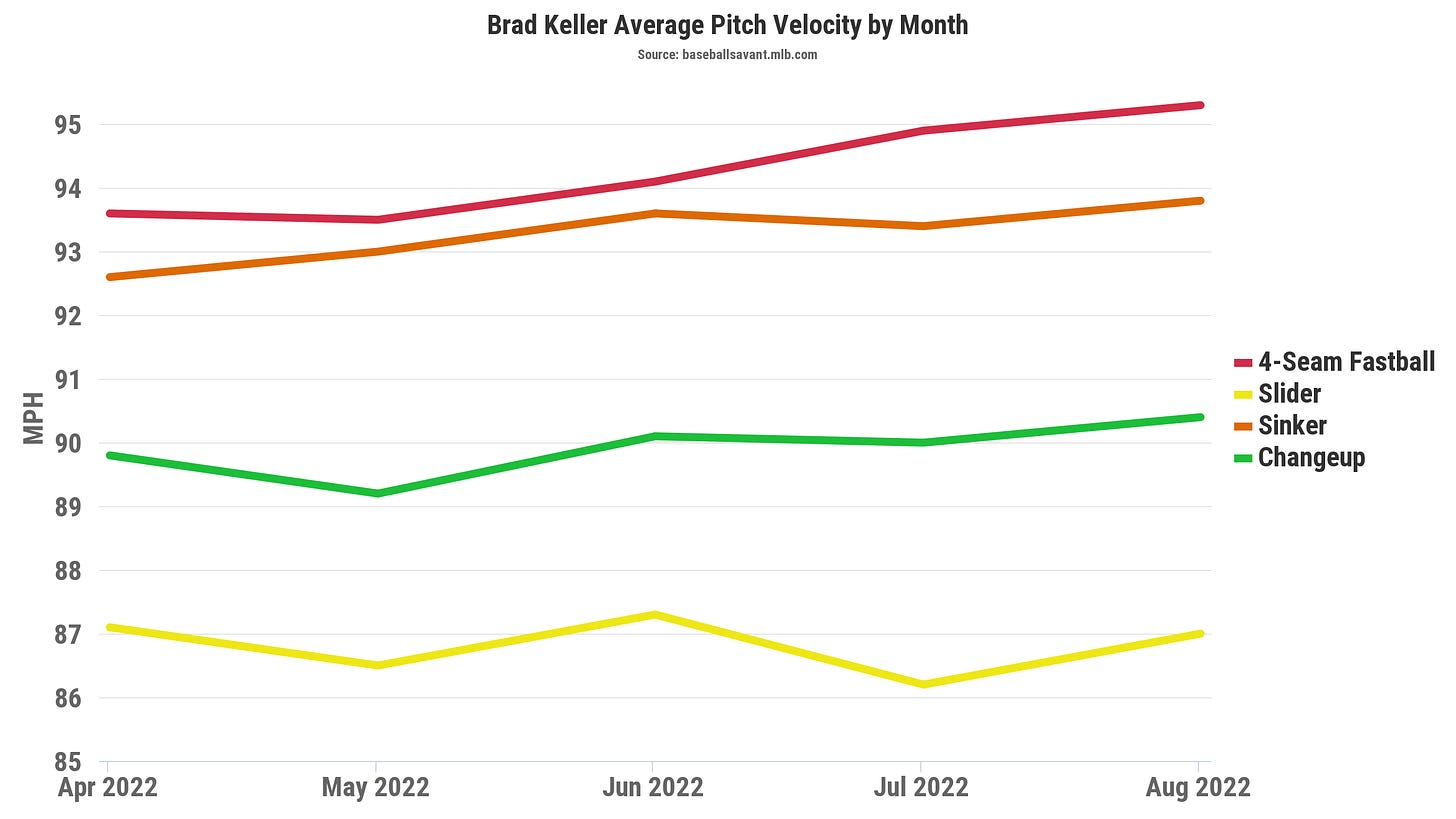The Royals shake up the rotation
The Royals have stopped scoring. Brad Keller is bounced from the rotation. Who is Thursday's starter?
The Royals got off to a good start in their three-game series against the Twins. They scored twice in the first inning of the opener on Vinnie Pasquantino’s eighth home run of the year.
They didn’t score again.
In getting shutout in the finale on Wednesday afternoon, the Royals have now gone 26 consecutive innings without a run. They were 1 for 22 with runners in scoring position in the three games in Minnesota. The starting pitching has been ok for the most part and except for Tuesday’s late bullpen implosion, so too has the bullpen. But you can’t compete if you can’t score.
As much as I don’t want to sound like an apologist for this club (you have Bally’s Sports if you need that slant), this is part of the deal we made. The Royals are rolling six or seven rookies out in the starting lineup every night. When things click, it’s the dopamine we crave to give us that boost for the future. However, the lows will bite. And with a rookie-heavy lineup, there will be lows. Just remind yourself that it’s better to watch Nate Eaton and Nick Pratto trying to figure out things at the big league level than it is watching Carlos Santana, Whit Merrifield and Andrew Benintendi searching for the escape hatch.
My wish list for the final six weeks of the season is to see some steady improvement from the Baby Royals. To go further, I’d like to see them press their thumb on the scales of the race for the AL Central championship. Eighteen of their final 33 games will be against the top three teams in the AL Central. They have opportunity. Spoil someone’s October. Make some enemies. Have some fun.
As the Royals were set to wrap their three-game series in Minnesota on Wednesday morning, the probable starters for the upcoming set in Tampa were set. Brad Keller was slated to start on Thursday according to the game notes released by the club.
Not so fast.
Meeting with the media a couple of hours before the first pitch, manager Mike Matheny announced a change in plans. Not only would Keller not be making his scheduled start on Thursday against the Rays, he would be moving to the bullpen.
Matheny on the move:
“We believe this is something that’ll be good for our club, kind of assessing our team and where we are and what we have. It’s something good for Brad. Hopefully, an opportunity for him to really shine and thrive, and believe it’s going to be good for our club as well moving forward.”
Not counting the Covid-abbreviated 2020 season, this will be Keller’s fourth full season in the majors. He opened the 2018 season in the bullpen but was eventually shifted to the rotation about halfway through. His 2019 season finished at the end of August as he was battling what the Royals termed as “arm fatigue.” In 2021, a grade 2 lat strain ended his season around the same point. And now this move to the bullpen.
Here’s Keller’s workload for those seasons, including this year:
2018 - 140.1 IP
2019 - 165.1 IP
2021 - 133.2 IP
2022 - 122.1 IP
That averages out to 140 innings per “full” season. So with about seven weeks left in the season, you could interpolate that Keller’s tank is running close to empty. It’s certainly allowed given that we’re close to September, a month where Keller has made just four starts in his career (again, not counting 2020).
I realize I’m heavily implying fatigue is playing a role in Keller’s move to the bullpen. It’s possible that’s a reason, but the data isn’t showing signs that he’s tiring.
Keller’s fastball velocity has increased as the season has evolved. In fact, the last two months where his four-seamer has averaged 95 MPH that’s the hardest he’s consistently thrown the pitch.
No, the real issue is, the fastballs are getting destroyed.
Remember how the Royals’ mantra has been about emphasizing first-pitch strikes? No major league starter is worse at getting a first-pitch strike than Keller this year. He’s getting one just 55.4 percent of the time. That’s last by a wide margin. Corbin Burnes (56.1 percent) and Charlie Morton (56.8 percent) are the only other qualified starters with a first-pitch strike rate worse than 57 percent.
When Keller falls behind in the count, he’s allowing a .286 BA and .397 slugging percentage. He’s allowing the opposition a 121 sOPS+, meaning he’s 21 percent worse than league average when falling behind 1-0.
According to Baseball Savant, Keller’s four-seamer was the second-least valuable pitch in the majors last year. (Jake Arrieta’s sinker was the worst.) Opponents hit .327 against it with a .513 slugging percentage. This year, the pitch has performed better with a .247 BA and .397 slugging percentage, but it’s still by far his worst offering. He’s mixing the four-seamer with his slider, using both almost equally this year. It’s a formula that worked for him in the shortened 2020 season, but it’s not happening for him this year.
Keller’s sinker isn’t far behind his four-seamer when it comes to poor results. According to Savant, Keller’s Run Value per 100 pitches is 1.2 on his four-seamer and 1.0 on his sinker. (A negative Run Value is what you want.) The sinker is getting ripped at a rate of a .355 BA and .495 slugging percentage. At least it’s his third pitch when it comes to usage.
He just doesn’t miss enough bats to be effective in today’s game. His 9.1 percent swinging strike rate ranks 52nd out of 60 qualified starters. Certainly, the ability to miss bats isn’t a prerequisite for success, but it takes a certain element of danger out of the equation.
Take a look at two of Keller’s peers who have a similar swinging strike rate. Jose Berrios has a 9.1 percent swinging strike rate, same as Keller. Martin Perez has an 8.7 swinging strike rate, worse than Keller. The difference is Perez gives up softer contact.
The question is, will the stuff play up in the bullpen? Given the shape and results off his fastballs, I’m a skeptic. Adding a tick or two to the velocity isn’t going to add value to the four-seamer or sinker. He needs movement, which is something both fastballs lack.
Sure, you can look at his ground ball rate that’s a bit over 50 percent and think that’s an ingredient for success—and it most definitely can be—but his proclivity to get hit hard means fastballs that opposing hitters can elevate travel some decent distance. And his inability to miss bats isn’t going to change from this shift. Maybe the road to success means dropping the sinker altogether and going just with a four-seam/slider combo. A reliever doesn’t need three pitches. Especially when that pitch doesn’t get the desired results.
Perhaps a more important question is, what does this mean for Keller’s future with the Royals? He will finish 2022 with five years of service time, meaning he will be eligible for arbitration for one last time before hitting the free agent market after the 2023 season. He’s making $4.825 this year, a 44 percent raise from his 2021 salary. He’s actually pitched better this year, so maybe a 50 percent increase is in line through the process. That would bump him to around $7.25 million. And that would be in the low range. So let’s estimate somewhere between $7.5 to $8.5 is what Keller will make in 2023. Do the Royals want to commit that to a reliever? I guess we’ll see how Matheny utilizes Keller out of the bullpen, but that’s high leverage reliever money. Does Keller shift back to the rotation? I’ve always maintained that Keller is, at best, a fifth starter on a team with eyes on contention. While the Royals won’t be at that point next year, they do have myriad options, both on the major league roster and on the farm when it comes to starters. And since Keller isn’t going to be in Kansas City once they are ready to contend, it does make sense to clear rotation space to see what the kids can do.
That’s my way of writing it sure looks like Keller will be a non-tender option this winter. And that’s probably for the best.
Who gets the ball on Thursday? Signs sure seem to be pointing to Max Castillo, one of the pitchers the Royals acquired in the Merrifield trade with Toronto. Castillo was scheduled to start on Wednesday for the Omaha Storm Chasers, but was scratched from that start. He’s already on the 40-man roster and has major league experience, making his debut earlier this year while he was with Toronto.
In fact, you’ll probably recall he made a start against the Royals in July, allowing three runs in three innings. He’s been on that kind of short leash, never topping 70 pitches in any of his nine major league appearances this season.
For Omaha, he’s made two starts. In his debut, he didn’t make it out of the first inning. His second outing went better where he went three innings. I imagine that seems like the best-case scenario if he does in fact make the start on Thursday.
Castillo’s success in 2022 has been due to ditching his two-seamer in favor of a four-seam fastball (ahem!). Castillo has a slider and changeup that he throws in addition to his four-seamer. He was the 12th-ranked prospect in the Jays’ system at the time of the trade. Baseball America slotted him in at number 24 in the Royals’ top 30 list.
He's shown the ability to land all of his pitches for strikes but his fastball command is above that of his secondary pitches at present. Castillo has the three-pitch mix and fastball command to project as a back-end starter almost immediately. He has the type of stuff and command that could also make him an asset in the bullpen long term.
Jackson Kowar could be an option as well, but also on a short leash. He last pitched on August 14, so he’d be a day ahead of schedule. And his results after returning to Triple-A still aren’t there. He has some work to do. Jonathan Heasley pitched for the Storm Chasers on Tuesday, so he’s not an option this time around.








I don't see any way they non tender Keller. But I believe this means he is getting traded this winter 100%.
I’m not a huge Keller fan. So while I don’t mind the move to the bullpen. If they non-tender him I find myself curious what exactly the plan is here because they need someone to throw innings next year. Going into the year we thought we had all these arms when in reality you never have enough arms. So while Singer, Lynch, Bubic are pretty much locks again next year. I guess….you resign Grienke…..but his numbers are so far off from Keller’s at probably a higher cost. Seems clear they have no other real choice but to go out and sign one…two…three guys this offseason? Even if you go with Singer, Lynch, Bubic, Greinke….you probably need to sign two guys as that is assuming ZERO injuries. Even then…Bubic and Greinke are 5’s at this point I believe. I hope it means a big trade or FA signing is coming. But man, they need more decent arms for next year.